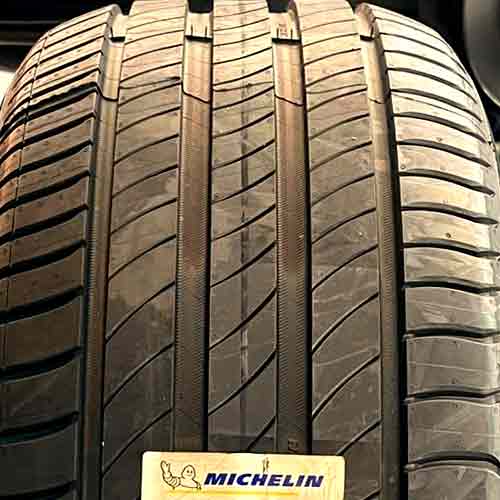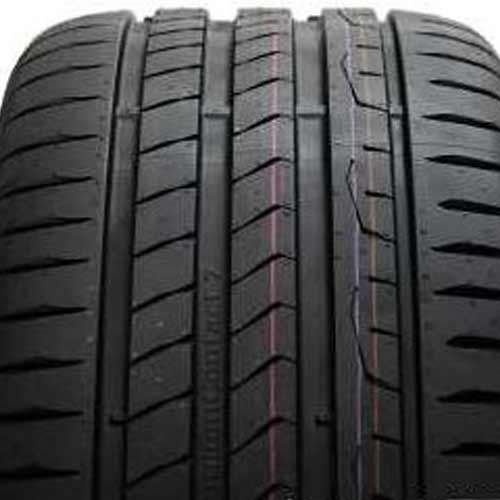Get ready for a comparative adventure as we dive deep into the features and performance of two amazing summer tires, the Continental PremiumContact 7 and the Michelin Primacy 4+.

When comparing both boys, each presents a unique set of strengths that cater to varied driving preferences. The PremiumContact 7 is a standout performer in both dry and wet conditions, excelling particularly in dry braking, handling, and wet road grip, making it a reliable choice for those who prioritize responsive control and stable handling. On the flip side, the Michelin Primacy 4 Plus offers a quieter ride at a more attractive price point, accompanied by superior rolling resistance that promotes fuel efficiency and excellent resistance to aquaplaning, ensuring a safer and more economical drive, especially during wet conditions.
Tread Noise
Tire noise largely comes from the interaction of air particles with the tire’s surface, especially within the shoulder grooves and lateral voids (as the tire rolls).
The air particles move swiftly through these areas, generating noise when they collide against the walls of the tread. In other words, basically air particles hitting against the rubber is what makes noise.
Now Michelin Primacy 4 Plus excels in reducing this noise due to its more compact shoulder area. This design minimizes air flow to a greater deal, cutting down noise at the source.
On the other hand, the Continental PremiumContact 7 tends to produce a bit more noise due to its larger voids in the shoulder lugs.
But its still not too far off, as it dampens the noise by utilizing advanced technology that modifies the sound pattern, using well-designed tread blocks that vary in shape and size.
Basically with varying geometry of these lugs, air particles hitting them produce a spectrum of tones, which then cancel out each other lowering noise levels.
Tread Design
Let me start off with the Michelin Primacy 4+.

So this tire has a pretty straight forward design, where it’s equipped with 5 total ribs.
The 3 ribs in the middle together form 4 circumferential grooves, where the outer two are narrower.
Moreover, they also carry similar siping slits, which vary in width.
And that combined with their curved geometry, you get superb wet traction, as these sipes get to remain flexible even under extreme braking and turns.
Moving towards shoulder lugs, you again get a minimalist design, where there aren’t any siping slits or notches.
These lugs only have lateral tread voids, again with a curved pattern. And since they are connected with the upcoming longitudinal channels, you get decent hydroplaning resistance.
On the other side, the Continental PremiumContact 7 comes with a asymmetric design, also forming 5 ribs in total.

Starting from the shoulder lugs, these ribs on both sides are continuous running, having thick cuts (slits) in them.
These slits act as in-groove biters/notches and provide with both wet and dry traction, in terms of handling, for the most part.
Moving towards the middle, here you see 3 central ribs, where all of them form unique designs.
These ribs are seen with thick laterally aligned cuts, which provide the needed biting on dry roads, and water soaking ability on wet.
And yes, one of the rib also has a combination of longitudinal and lateral siping slits further improving wet traction efficacy.
Together these ribs form 4 varying longitudinal aqua channels, which provide decent aquaplaning resistance.
Assessing Dry Grip
During my examination of the tires’ performance on dry roads, I focused on their traction, steering response, and cornering abilities. Here’s what I found.
Straight Line Traction
Longitudinal or straight line traction refers to the tire’s ability to maintain grip on a linear dry roads. And this dimension can be assessed by measuring braking distances and analyzing the central area of the tread, (which is the part that endures the most weight pressure during straight-line travel).
Now having said that, its easier to explain why Continental PremiumContact 7 showed slightly better performance in this regard, braking a bit shorter than its competitor, that is, (as seen on tests, on average).
This advantage is due to its larger middle contact patch and deeper sipes, which together with angled notches, provide better grip on the road.
On the other side, the Michelin Primacy 4 Plus, with its larger tread voids, wasn’t able to maintain the same level of contact with the road, slightly affecting its dry grip performance.
Dry Handling
Dry handling evaluates the tire’s performance during cornering.
Now turning efficacy of a tire is mainly measured by the lateral forces it experiences, where the shoulder areas (of the tire) are crucial because they bear more weight during cornering, (because of inertia).
Now here, it was seen (on tests), that both tires showed comparable results, providing excellent steering response and a good balance between understeering and oversteering.
This is because both of these boys feature shoulder lugs that offer a perfect blend of rigidity and flexibility, ensuring precise handling. But still, if I have to pick one here, I would go with the Continental PremiumContact 7, as it offers superior directional grip (as discussed in the above section).
Fuel Efficiency
Fuel efficiency in tires is significantly impacted by their rolling resistance, which is influenced by attributes such as the tread composition and the weight of the tire.
Now cutting to the chase, the Michelin Primacy 4 Plus showcases superior fuel efficiency characteristics, primarily owing to its reduced rolling resistance.
Although it is a heavier tire, the stiffer composition of its material enables it to resist unnecessary flexing and bending as it moves.
Basically, this quality ensures energy conservation, preventing loss through tread flexing, or you can say molding, and that ultimately facilitates better fuel consumption rates.
On the other side, the PremiumContact 7 offering greater grip gets to have higher rolling resistance values, comparatively.
Vibrations Absorption
The smoothness of a tire’s ride is closely related to its capability to absorb irregularities, or you can say imperfections of the road.
And this is a quality which is largely defined by the tire’s internal and external composition and make-up. What I mean is that tires with a more flexible structure get to provide a more comfortable and smoother ride, as the pliant tread soak up the vibrations better.
In this aspect, the Continental PremiumContact 7 encounters difficulties due to its less flexible external tread.
Although internally it matches the rigidity of the Michelin tire, its exterior is less adept at absorbing road vibrations.
On the other hand, the Michelin Primacy 4 Plus exhibits a more adaptable tread structure, effectively absorbing vibrations thanks to multiple grooves and notches distributed across the tire’s tread, contributing to a smoother ride.
Tread Life
Tread life longevity is determined by various factors where some main dimensions to consider are the rolling resistance, the composition of the tread, and its depth.
So basically, stating the obvious, a high rolling resistance speeds up the rate of tread wear, however, a deeper tread depth can balance this out since it takes a longer time to reach the minimum legal limit, (which is 2/32″ in the USA).
Regarding the Michelin Primacy 4 Plus, its more considerable weight is balanced out by a slightly deeper tread depth and a firmer rubber composition, which results in sustained road contact and a slower rate of wear.
Whereas, its Continental counterpart tends to generate more heat due to its tread rubber, a factor that contributes to a faster tread wear rate not just compared to its competitor here, but also other high performing tires in the category.
Performance on Wet Surfaces
The efficacy of a tire on wet surfaces is majorly dictated by its ability to maintain a strong grip while preventing hydroplaning, primarily achieved through efficient water displacement mechanisms.
In wet conditions, the Continental PremiumContact 7 stands out, surpassing most high-performance summer tires in terms of handling and braking.
This was basically evidenced by its impressive performance in stopping distance tests and lap time trials.
Though the tire could use some help when it comes to hydroplaning resistance (as seen on curved and straight aqua testing).
Hydroplaning has to do with tire’s water evacuation capabilities, and in this tire’s case, those are slightly hampered due to closed shoulder voids and a somewhat rigid compound.
(Rigid rubber compounds don’t allow a good enough negative pressure build up, and so water isn’t thrown out fast enough).
In contrast, the Michelin Primacy 4 Plus excels in preventing hydroplaning, ensuring remarkable stability on both straight and curved wet surfaces. Nonetheless, it falls a bit short in handling and braking efficiency.
Basically its lug alignment results in marginally extended braking distances, and the balance between understeering and oversteering could be improved to enhance overall performance on wet surfaces.
To Sum Up
The Continental PremiumContact 7 excels in:
- Dry Grip Performance: With a larger middle contact patch and deeper sipes, this tire offers superior traction on dry surfaces.
- Wet Surface Handling and Braking: The tire showcases impressive performance in wet conditions, particularly in handling and braking, surpassing many high-performance summer tires in this aspect.
- Cornering Abilities: Its well-designed shoulder lugs ensure a perfect blend of rigidity and flexibility, providing excellent steering response and with it cornering, as seen by greater (measured) lateral g forces.
While the Michelin Primacy 4 Plus is better in:
- Fuel Efficiency: Due to a stiffer composition and reduced rolling resistance, this tire promises better fuel efficiency.
- Vibration Absorption: Featuring a more adaptable tread structure with multiple grooves and notches, the tire is more proficient at absorbing road vibrations.
- Tread Life: Combining a slightly deeper tread depth and a firmer rubber composition, this tire lasts longer.